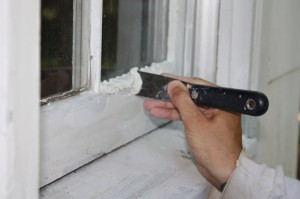.
Last Saturday I took my 10-year-old son along with me to repair a window in one of our rental houses. I like to take one of my boys along so they can learn a thing or two about how to repair things, as well as so they can see how I deal with tenants, and, mainly so that we spend some time together and have fun together. I always try to make it fun for them. For example, we went to ACE Hardware to get a new window cut, we looked at the stuff he likes to see, like BB guns and rockets, and, I bought him a bag of Boston Baked Beans.
It was really a big help to have #2 son along. He not only does what I ask him to do, unlike his teenage brother “Mr. Cool Guy”, but he also brings an enthusiastic spirit to the endeavor. One of the first things I have to do is to chip out the old putty from around the window. It’s my least favorite part of the job since it involves a lot of tedious work. After I explain what I am going to do, my son responds. “Can I do it?” I say “okay, go at it,” but I’m thinking, “Well, if you really insist!” What is old hat to me is new and exciting to him.
When we arrived back from ACE with the new window, I accidentally broke the window as I took it out of the back seat of my pick-up. I thought it might discourage my son to head back to ACE again to buy another window, but his response was, “I need a refill on the Boston Baked Beans anyway.” After that the broken glass incident became a running gag with comments like “is it time to break the window again?” and “let’s break the window again and get some more Boston Baked Beans.”
I must admit, it’s not nearly as entertaining when I have to do those little repair jobs all by myself.
Related Posts





